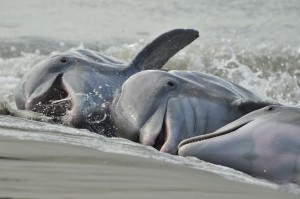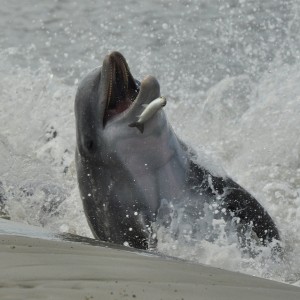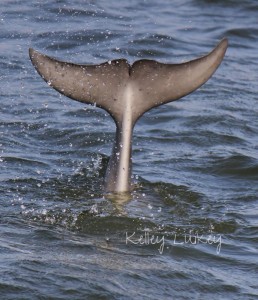Lowcountry Dolphins : Clever Hunters on South Carolina's Coast
Some of the most remarkable behaviors to witness in our inshore waters are the incredible feeding methods of our Lowcountry Dolphins.
The common bottlenose dolphin (Tursiops truncatus) is a charismatic and beloved sight in our Beaufort waterways. Intelligent and social – they travel, feed, play, and rest in groups and are active throughout the day and night. Local residents and visitors alike are fortunate to have the opportunity to frequently observe these beautiful creatures in their natural habitat.
Bottlenose dolphins consume approximately five percent of their body weight a day; roughly 15-30 pounds of fish, squid, and crustaceans depending on the size of the dolphin. They employ a diverse array of foraging strategies, many of which are complex and likely learned. Some of these behaviors involve single animals while other techniques involve dolphins working together in a coordinated effort. With flukes slapping, water splashing and fish leaping, many of these feeding methods create an impressive visual and acoustic display that an observer will not soon forget.
Lowcountry Dolphins: Strand Feeding
Perhaps one of the most impressive feeding techniques to observe in our area is a type of cooperative feeding behavior that is unique to South Carolina and Georgia. This method is termed strand feeding and is so-called because the dolphins partially strand themselves temporarily on the shore to feed.
First documented in 1971 (Hoese) in the shallow marshes of Georgia, strand feeding involves a group of dolphins operating as a unit to capture schooling fish. Working at low tide, the dolphins synchronize their movements underwater to corral the fish towards a bank. The dolphins then make a strong push towards the shore, creating a bow wave and forcing their prey onto the mud. The sheer force of them hurling their bodies towards the shore as a group is an extraordinary display and not without risk. The dolphins consume the fish on the bank and must quickly slide or shimmy back into the water before they become stuck in the mud and face a host of hazards.
Fish-whacking, kerplunking and pinwheeling (yes, these are actual scientific terms) are just three examples of dolphins working alone to capture prey.
Fish-whacking occurs when a dolphin will debilitate a fish by using its flukes to whack the fish. The prey is often hurled it into the air and stunned, thereby making it a breeze for the dolphin to retrieve and eat. Kerplunking is another method in which a dolphin will use a fluke-slap to produce a “kerplunk” sound. The tail splash creates bubbles under the water, flushes the fish from their hiding spots and makes it easier for the dolphins to detect them. The pinwheel strategy occurs when the dolphin rotates to swim on its side, accelerates at an extremely fast rate and circles schooling fish into a tight circumference in order to intercept the fish. This high-speed pursuit creates an astonishing exhibition of agility and maneuverability.

Lowcountry Dolphins: Beach Hunting
A similar foraging strategy called beach hunting has been noted in bottlenose dolphins in other locations around the world. However, it involves solitary dolphins rather than a synchronized group and does not appear to be practiced on a regular basis.
Dolphins utilize a repertoire of techniques to hunt prey, all of which are a testament to their intelligence, agility, and maneuverability. The patient Lowcountry observer, whether out on the water by boat or simply watching from shore, can observe our local bottlenose dolphins navigating the intricate maze of our tidal marshes, creeks, and rivers.
The lucky onlooker may be rewarded by witnessing one of their ingenious foraging displays…a truly spectacular experience.

Article by Kelley Luikey.
Follow more of Kelley’s fabulous local nature photography on her Facebook page, at Nature Muse Imagery








